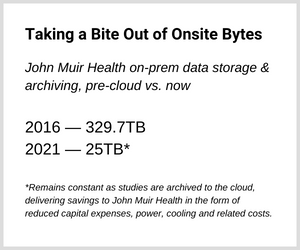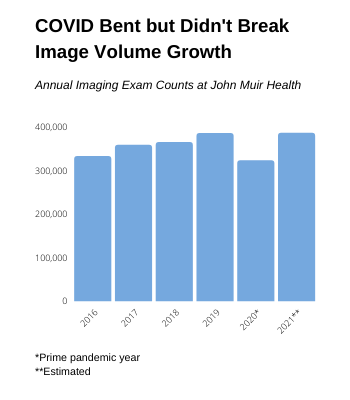By the numbers improved and the feats accomplished
John Muir Health has made numerous operational improvements supported by Sectra Health Cloud and Sectra One Cloud Services. Here are some of the areas in which the impact has been greatest:
Reliability, aka uptime maximization. Before going to the cloud, John Muir Health IT sweated out quarterly planned downtimes. The time was set aside to expand storage, upgrade firmware and perform other time-consuming maintenance tasks. “We would have five or six hours of downtime a year just to work on PACS,” Tedlock recalls. “With the Sectra cloud solution, we have none of that downtime. Our total downtime now is just a few minutes per year.” Just for peace of mind, the team keeps roughly two years of images on the premises. To the end user, says infrastructure expert-turned-cloud specialist Marty Tedlock, “there will never be any impact at all from maintenance downtimes.”
Customer (end user) satisfaction. By all but eliminating downtime, the team has averted “heated moments with radiologists in downtime follow-up meetings,” Bartlett notes. “We don’t miss talking with them about ‘what went wrong with the computers’ and how to keep it from happening again.”
Staffing stability. The good news is that not a single member of John Muir Health IT or applications support, including PACS service, has lost a job to the cloud. Yet the technical team has not had to hire a single FTE, either—even though the institution has added locations, expanded services and grown imaging volumes. “We’ve been able to do more projects with the same headcount,” says Associate VP for Application Delivery Judy Bartlett. “We’ve been able to provide more at-the-elbow support and make lots of other value-add contributions.”
Overspending avoidance. John Muir Health has reduced its reliance on pricey service contracts for hardware maintenance, Tedlock reports. He doesn’t need to pay for dedicated maintenance on terabytes of storage because that’s all taken care of in the cloud now, he says. “There is a cost to that but only when I use it: I’m billed as I add images. You purchase a big storage array, you’re going to be paying maintenance whether you use all that storage or not.”
Budget mindfulness. There are situations in which switching to cloud storage and computing wouldn’t be a sound financial move. However, in the case of John Muir Health, Sectra is taking on the risk for maintaining certain applications, backups, upgrades and more, Tedlock says. “That’s a cost savings back to John Muir that we haven’t quantified yet, but it’s a real savings in labor and in time that’s better spent on other duties,” he says. “If I’m saving labor dollars and the risk is shifted to the vendor to support the platform, that’s a huge savings.”


 “We had been looking to replace dedicated storage for PACS when the SAN failed,” Tedlock remembers. “The CIO said, ‘Well, we can’t go that route anymore. We’ve got to head somewhere else altogether.’”
“We had been looking to replace dedicated storage for PACS when the SAN failed,” Tedlock remembers. “The CIO said, ‘Well, we can’t go that route anymore. We’ve got to head somewhere else altogether.’” Wound care is slated to begin migrating early next year, to be followed as soon as feasible by endoscopy, pathology and newly acquired specialty practices that are joining John Muir Health with their own imaging systems.
Wound care is slated to begin migrating early next year, to be followed as soon as feasible by endoscopy, pathology and newly acquired specialty practices that are joining John Muir Health with their own imaging systems.


